Ellinor Davenport Adams
Ellinor Davenport Adams (birth registered in the fourth quarter of 1858 – 11 April 1915) was a British journalist and author. She wrote mainly girl's fiction, and told her stories from the child's perspective.
Ellinor Davenport Adams | |
|---|---|
| Born | 1858 |
| Died | 11 April 1915 (aged 56–57) Putney, London, England |
| Nationality | British |
| Other names | Ellinor Lily Davenport Adams |
| Occupation | Author and Journalist |
| Years active | 1878–1903 |
| Known for | Girls' fiction |
Biography
Ellinor Davenport Adams[note 1] had her birth registered in the forth quarter of 1856.[1] She was the third surviving child, and second surviving daughter[note 2] of William Henry Davenport Adams (5 May 1828 – 30 December 1991),[2] a journalist and author, and Sarah Esther Morgan[note 3] (13 August 1835–1908)[3][4], the daughter of shoemaker Timothy Morgan. The couple had married at St. Mary's Church in the Parish of Paddington, London on 26 December 1850.[5]
The family as a whole were quite involved in literature and drama. Her father had over 100 books to his credit,[6] and her eldest brother, William Davenport Adams (28 December 1851 – 26 July 1904) was a noted journalist and author.[7] Her elder sister, Florence Mary Susan Ballingall (4th quarter 1855 – 4th quarter 1943)[8][9] was also a journalist and writer, who wrote children's one-act plays, mainly about fairies.[10][11][note 4]}} Her brother Alfred Elliot (later Davenport) Adams (1st quarter 1861{{snd}1947)[18][19] became an actor,[20], and married an actress.[21][22]
It is not clear what education Adams received. The census returns show no governess living in the household. Her father was himself a schoolteacher and a family tutor[2] and may have instructed his daughters[note 5] while working as an editor and generating his prolific literary output. Her father had a large library of standard works and Adams was reading these at the age when most children are reading story books.[24] The plot of her first book concerns a nine-year-old girl who is sent to a day-school run by a retired colonel and his sister, Colonel Russell's Baby 1889. The heroine was called Lily with a father who edited a provincial newspaper, like Ellinor herself, and who does not have the time to educate her.[25]
Adams lived with her sister Florence her whole life.[24] Although Florence had married in 1877, the 1881 census, only four years later, showed her living with Adams, her parents, and her younger brother at Victoria Road, Solihull, Birmingham. The 1891 census found Adams and Florence living with their parents at 46 Alexandra Road in Wimbledon, London,[note 6] the address at which her father died on 30 December 1891.[2]
Both Adams and Florence gave their profession or occupation as "Literary" in the 1891 census. By 1901 Adams was living with her widowed mother and Florence, also a widow,[note 7] at 67 Chelverton Road in Putney, London, where she gave her profession or occupation as "Author". Adams was still living at 67 Chelverton road with Florence at the time of the 1911 census, both now giving their profession or occupation as "Journalism and Literature".
Adams's seems to have published no new books after 1902. This may have been because she took her brother's literary reviewing work at the Globe after his death in 1904, and her work for Blackie and Son, which continued up to her death.[24] Her mother died in 1908,[4] leaving Adams and her sister alone in the house with one servant. Adams's health gradually declined and she died at home on 11 April 1913. Her death certificate records that she had suffered from chronic bronchial asthma for many years, and that after suffering for 14 days from pleurisy, she lost consciousness and died.[26] She was buried in Putney Vale Cemetery on 16 April 1913.[24]
Work
Adams's first published work in a book appears to be her story Wild Raspberries: a tale of love and adventure which was one of five stories in St. Quentin's, a village tale published by the Edinburgh Publishing Company, Edinburgh, 1828. , and other stories, by Gertrude Douglas and others). Adams was 27 at the time. Her first long story of girls, Colonel Russell's Baby was published in 1889, but her obituary notes that she wrote the story in her girlhood.[24]
She had long worked with her brother William Davenport Adams, who was on the editorial staff at "The Globe" in his work as a literature reviewer, and took over from him after his death, holding the post for several years.[24]
Ellinor wrote girls' stories mostly.[27]:67-68 Most of her later stories were published by Blackie and Son for whom she acted as a publisher's reader.[24][note 8] Several of her later books were graduated readers for use in schools.[28]:31
Books
The following list of works has been drawn mainly from a search[29] on the Jisc Library Hub Discover website,[note 9] supplemented by searches for confirmation of details or for any missing details at the British Library, WorldCat, and in the British Newspaper Archive. Adams also wrote serial stories, not all of which seem to have been published in book form. In particular The Wonder Workers the story of a household of girls who go to London to make their fortunes began as a serial in The Girl's Own Paper in May 1903.[32].
| Ser | Year | Title | Illustrator | Publisher | p. | Notes |
|---|---|---|---|---|---|---|
| 1 | 1878 | Wild Raspberries: a tale of love and adventure (a story in St. Quentin's, a village tale, and other stories, by Gertrude Douglas and others) | Edinburgh Publishing Company, Edinburgh | 184 p., 8º | [note 10] | |
| 2 | 1886 | The illustrated poetical birthday book, with a supplement of female Christian names and appropriate quotations | W. Mack, London | 292 p. ; 16º | [note 11] | |
| 3 | 1889 | Colonel Russell's Baby | W. Smith & Innes, London | [4], 430p., 8º | [note 12] | |
| 4 | 1891 | Comrades True | Edith Scannell | Oliphant, Anderson & Co, London | 304 p., 6 ill., 8º | [note 13] |
| 5 | 1891 | Robin's ride | Walter S. Stacey[note 14] | Cassell and Co., London | 192, 16 p., 20 ill., 8º | [note 16] starting in January 1891. The book tells the story of a little boy who make a dangerous ride through the snow to get something to please his playmates. The Globe calls it a "pleasant volume" and states that is shows a lot of knowledge of child life and character.[45]</ref> |
| 6 | 1894 | The disagreeable duke : a Christmas whimsicality for holiday boys and girls | Emily J. Harding[note 17] | George Allen, London | 8,114, 6 p., 8 pl., 8º | [note 18] |
| 7 | 1896 | Little Miss Conceit | Hannah Clarke Preston MacGoun | Oliphant & Co, London | 112 p., 8º | [note 19] |
| 8 | 1896 | The Palace on the Moor | Edward Arnold, London | 192, 32 p., 4 ill., 8º | [note 20] | |
| 9 | 1896 | The holiday prize, a modern fairy tale | Kenneth Mathiason Skeaping | Jarrold & Sons, London | 205, 18 p., ill., 8º | [note 22] in the village gather for the summer holidays at the Squire's his maiden sister offers a prize to the boy who becomes the most perfect embodiment of a knight. The Gentlewoman called the book "bright and imaginative", and formed the initial volume of Jarrold's new Snug Corner Series.[56] The Dundee Advertiser found that the fairies met with in the book were very real, and that the book taught "a gentle yet effective lesson" on courtesy.[57]</ref> |
| 10 | 1897 | May, Guy and Jim; with other stories, etc. | John Henry Frederick Bacon | Blackie & Son, London | 192 p., 8º | [note 23] |
| 11 | 1897 | Miss Secretary Ethel, a story for girls of to-day | Harry Furniss[note 24] | Hurst and Blackett Ltd., London | 255 p., ill., 8º | [note 25] |
| 12 | 1899 | A Girl of To-day, etc. | Gertrude Demain Hammond | Blackie & Son, London | 288 p., 6 ill., 8º | [note 26] |
| 13 | 1899 | Miss Mary's Little Maid | [note 27] | Blackie & Son, London | 112 p., 13 ill., 8º | [note 28] |
| 14 | 1899 | A queen among girls | Harold Copping | Blackie, London | 288p, 6 ill., 8º | [note 29] |
| 15 | 1900 | Betty the bold | Edith Alice Cubbitt | Blackie & Son, London | 112, 24 p., ill., 8º | [note 28] |
| 16 | 1900 | Granny's coach-and-four | Percy Tarrant | Edward Arnold, London | 105, 7 p., ill., 8º | [note 31] |
| 17 | 1901 | Little greycoat | Edith Alice Cubbitt, Talwin Morris, Chris Mullen | Blackie & Son, London | 80 p., ill., 12º | [note 32] |
| 18 | 1901 | On Honour. A school and home story | T. Nelson & Sons, London | 332 p., 4 col. ill., 8º | [note 33] | |
| 19 | 1902 | Elsie Wins! | H. M. Brock and Audrey J. Watson.[note 34] | Blackie & Son, London | 111, 8 p., col. fs, ill., 8º | [note 35] |
| 20 | 1902 | Those twins! | Susan Beatrice Pearse[note 36] | Blackie & Son, London | 211, 32 p., 28 ill., 8º | [note 37] |
Example of illustrations for a book by Adams
Kenneth Mathiason Skeaping (13 December 1856 – 16 May 1946)[72][73], a lithographer, portrait painter, and illustrator,[note 38] illustrated A Holiday Prize with 35 illustrations, shown below, plus a decorative title page, decorative heading bands for each chapter, and silhouettes for each end of chapter.The Gentlewoman said that The Holiday Prize, already a bright and imaginative tale, was "still further enhanced by the artistic illustrations" of Skeaping.[56]
 Page-010
Page-010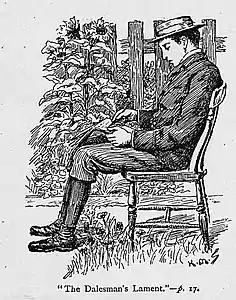 Page-017
Page-017 Page-018
Page-018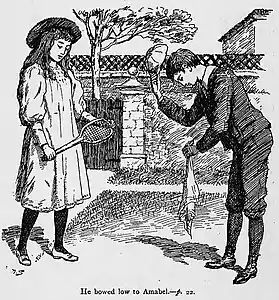 Page-022
Page-022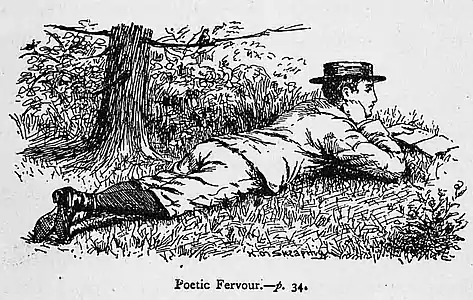 Page-034
Page-034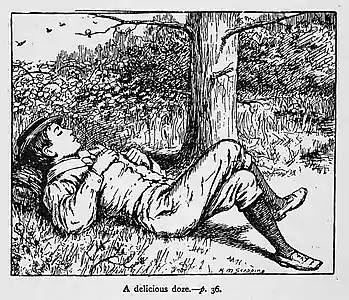 Page-036
Page-036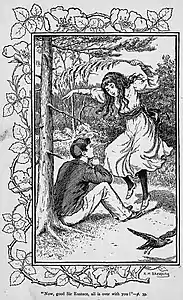 Page-039
Page-039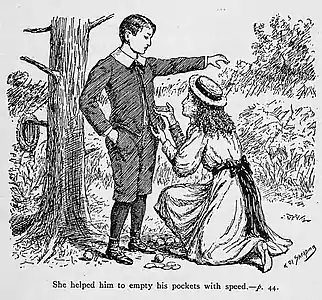 Page-044
Page-044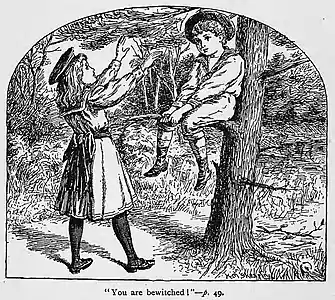 Page-049
Page-049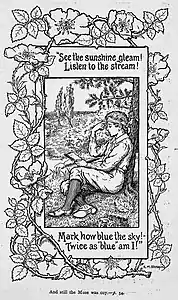 Page-054
Page-054 Page-058
Page-058 Page-064
Page-064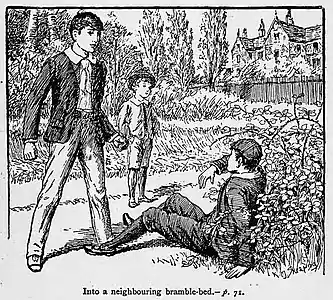 Page-071
Page-071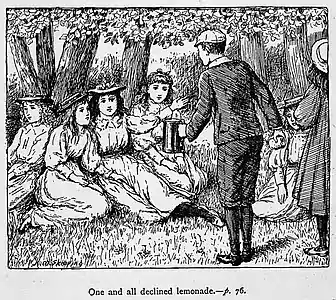 Page-076
Page-076 Page-081
Page-081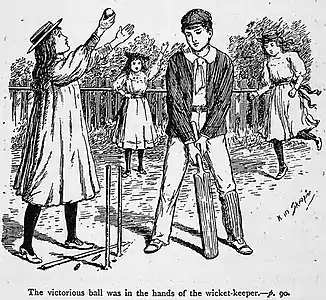 Page-090
Page-090 Page-094
Page-094 Page-098
Page-098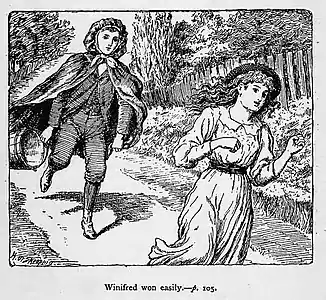 Page-105
Page-105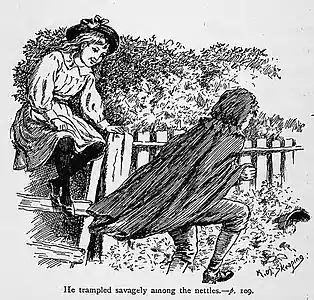 Page-109
Page-109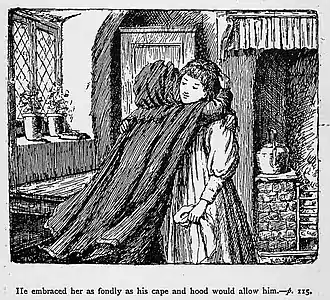 Page-115
Page-115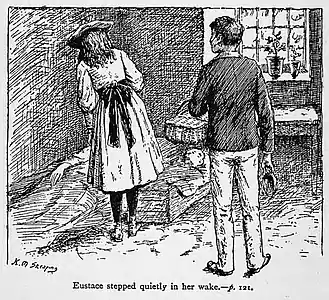 Page-121
Page-121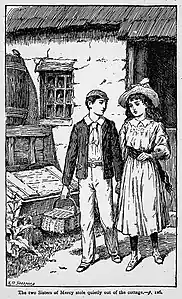 Page-126
Page-126 Page-134
Page-134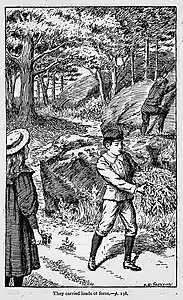 Page-138
Page-138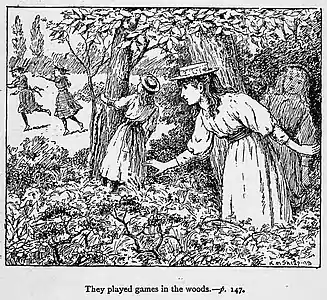 Page-147
Page-147 Page-152
Page-152 Page-156
Page-156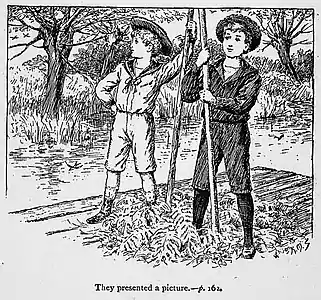 Page-162
Page-162 Page-169
Page-169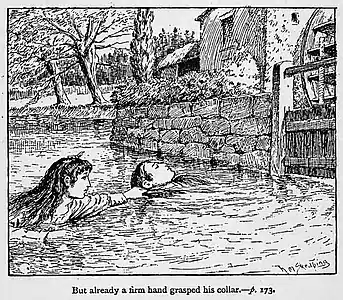 Page-173
Page-173 Page-186
Page-186 Page-191
Page-191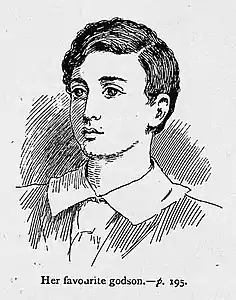 Page-195
Page-195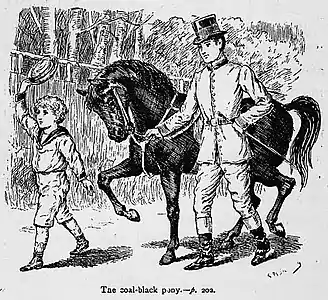 Page-202
Page-202
Assessment
Sims and Clare state that Adams "typifies the turn-of-the-century girls’ writer in many ways" and that her books "are half-way between the Victorian tale which sought to provide moral edification and its successor which hid the pill in a very heavy coating of sugar."[27]:68 Her obituary [note 39] states that Adams "had a strong sympathy with children" and "understood the needs of girls", which enabled here to given to every story a definite plot and real characters.
Sims and Clare state that Adams's treatment of children who have been warped or stunted by neglect on the part of their adult carers is particularly interesting.[27]:68 Many of her books are written from the perspective of the child protagonists. Her first published novel Colonel Russell's Baby is told from the perspective of a girl, who is nine at the start of the story, and is a study of her character, "unsparingly minute in its method". In her case, her mother has died and her father has little time for her, and she suffers at the hands of her Latin master.[39] Robin's Ride is again told from the point of view of the youthful protagonist.[45] Repeatedly, reviewers noted that Adams has a "close knowledge of youthful character and habits",[37] or that her work shows "much knowledge of child life and character".[45] Sims and Clare call her characterisation of two sisters in On Honour, who have been badly brought up by a mean and selfish aunt, "moving and credible".[27]:68 Little Miss Conceit was an "excellent study of child character", where again a child is forced into a role for which she is ill-prepared.[51] In A Queen among Girls the heroine defends her weakly brother from the unfair judgement of her uncle.[77]
Although some of Adams's older heroines aspire to be "new girls" in the sense advocated by Alice Corkran in her editorial of early 1899 in The Girl's Realm[78], or as described by Sally Mitchell in her landmark 1991 study The New Girl: Girl's Culture in England 1880-1915[79] they are more firmly wedded to being "nice girls".[80] This is demonstrated by Augusta in A Queen among Girls who abandons her dreams of a professional career,[28]:18 which a reviewer characterises as "selfish dreams",[81] to protect her sickly younger brother from his overbearing uncle, thus exchanging the role of "nice girl" for that of "new girl".[80] In Miss Secretary Ethel Adams make the contrast between "new girls" and "nice girls" all the more obvious in the character of the Girton feminist, quite clearly a "new girl" who is contrasted with the heroine.[61]:219 In this case, the "new girl" of an efficient secretary is replaced by the "nice girl" as she is adopted by her former employer and his wife.[62]
Notes
- Her name is sometimes spelled as Eleanor or Elinor Lily Davenport Adams
- In addition to the four children who survived to adulthood, Adam's parents had two other children who dies in infancy.[2]
- Sarah Esther was later known as Lily Davenport Adams
- Florence married Charles Campbell Ballingall (1849–27 October 1896),[12][13] then the chief clerk of the Lancashire Insurance Company at Birmingham, in Edinburgh on 31 March 1877,[14] and the 1911 census shows that she bore no children. The marriage seems to have been a failure, as Florence lived apart from her husband. Her parents had already moved to Birmingham by the 1881 census, where Ballingall had been working in 1877, he had already moved to Inverness to be the resident secretary there for the company by 1879,[15] he was promoted to assistant secretary in Edinburgh in 1890,[16] and to resident secretary there in 1894.[17]
- His eldest son was sent to at Merchant Taylors' School[23] in London, and later to the The Glasgow Academy
- While the 1881 census showed Florence as married, and uses her married name, the 1891 census showed her as single and uses her maiden name, and the 1901 census as widowed and uses her married name.
- Adams's father had died in December 1891 and her brother-in-law in 1896.[13]
- Her father had also been a reader and author for Blackie.[2]
- The Jisc Library Hub Discover brings together the catalogues of 168 major UK and Irish libraries. Additional libraries are being added all the time, and the catalogue collates national, university, and research libraries.[30][31]
- One of five stories in the volume. The five authors were Gertrude Douglas, Charles Holcroft, Mrs. Hibbert Ware, Adams, and Evelyn Everett-Green.[33] The Glasgow Herald said that the stories were "of a healthy tone and . . . the plots are unravelled with a fair amount of skill".[34] The Examiner considered tha the shortcomings of the first four stories was atoned for by the pathos of the story by Everett-Green.[33]
- Available on-line via Google Books.[35] The book consists of pages with three dates, each of which has at least one poetry extract, interspersed with pages with those dates with spaces for entering the names of the persons whose birthdays fall on those dates. The illustations take the form of floral borders for a poem before the beginning of each month. The Appendix of female christian names has fifty names, each with one or two poetry extracts.
- Available on-line at the British Library.[36] The "clever and unconventional book"[37] met with somewhat mixed reviews, with the Morning Post considering that it was "unpleasant and full of false sentiment",[38] while The Globe found it to be "a singular and original study" of the character of an individual child, and found that it never failed "to convey a sense of complete reality in matters of feeling"[39] and the Illustrated London News said that Adams had "bestowed on this small single figure of girlhood emerging from infancy as much thoughtful study of the growth of feminine moral and intellectual capacities as some other better-known authoresses have spent in representing the early lives of numerous groups of sisters, cousins, or schoolfellows. . ."[25]
- The plot centers around the friendship of a boy and a girl, who remain true friends in the face of adversity. The Aberdeen Free Press considered it an "excellent, wholesome, and well-written story."[40] The Aberdeen Free Press said that the book would delight both boys and girls.[41] The Graphic decided that while the tale was improbable, it was "nicely told all the same".[42] The Gentlewoman thought the story was like a breath of an invigorating sea breeze.[43] The Inverness Courier judged it to be "as pleasant book for children."[44] The Globe called this "a considerable advance . . . in literary skill and effect" upon her previous book Colonel Russell's Baby.[37]
- In reference to Stacey's work, The Globe called the book "attractively illustrated".[45]
- Myra's Journal of Dress and Fashion was a monthly journal which featured colour illustrations of fashion, as well as household tips and serialised short novels. It was started by the husband of the late Mrs Beeton and Matilda "Myra" Browne in 1875<ref name='Beeton-Hughes' group=''>
- Initially published as a serial in Myra's Journal of Dress and Fashion[46][note 15]
- The Birmingham Daily Post said that Harding's illustrations for The Disagreeable Duke reached "a very high level of merit",[47] and the Manchester Courier called her illustrations "quaint and pretty".[48]
- The plot centres around a band of children who plan to steal a fir tree from a disagreeable Duke and replace it with a note. The Birmingham Daily Post[47] called it a "first rate little story of children's affairs". The Manchester Courier called it a "a charming story", and "a capital Christmas story."[48]
- The plot centres around the fifteen-year-old daughter of a widow who has younger sisters and a younger brother, who earns the title "Little Miss Conceit" by being too proud for both domestic duties and for playing with her younger siblings.[49][50] The Globe calls it "an excellent study of child-character"[51]
- In the Children's Hour Series, the attached catalogue was illustrated, but it is not clear if the book was. The story centres on a young boy who is sent home from India to join his elder sisters in England. He is not robust and lively, but proves his worth. The Manchester Courier called it an "interesting story".[52] The Liverpool Mercury called it "a capital children's story".[53] The Globe said that the story was "full interest for boys end girls" and was "told with sympathy and humour".[54]In the Children's Hour Series, the attached catalogue was illustrated, but it is not clear if the book was.
- The Children "of fair degree" are the children of middle-class parents, including the Squire's children the Rector's children, the doctor's children, and the children of retired colonels, a naval captain, a lawyer, and others.<ref name='Holiday-Ellinor' group=''>
- The book is available online from the University of Florida Digital Collections.[55] There are no fairies as such in the book. When all the children "of fair degree"[55]:12[note 21]:9-10
- A collection of short stories, which The Globe called "agreeably fresh in subject and in treatment"[51] St. James's Gazette said that the book was unsuitable for younger boys and girls, but only for those who were almost grown up because the "character-drawing is above the heads of children" but apart from this the stories were charming.[58]
- The Dundee Advertiser states that Miss Secretary Ethel in enhanced by Furniss's "beautiful illustrations".[59]
- The plot centres around the story of an older girl who, because of the illness and poverty of her foster parents, becomes secretary to a rural Baronet with Parliamentary ambitions.[60] She is so efficient that her boss fires her because of his growing dependence on her.[61]:218 However, she soon returns to her employer in another capacity.[62]
- The boys and girls of Woodend band together to form a Society of Altruists to help their poorer neighbours.[28]:18
- Margaret E. Thompson, born in Calcutta in 1873,[63] was a figure and flower painter as well as an illustrator.[64] Her initial forte was murals and vases with motifs of fairies and elegant ladies She was one of Doulton’s leading designers by 1912.[63]
- This was one of Blackie and Son's one-shilling graduated readers. Each had a colour frontispiece and black and white illustrations. The one-shilling series were intended for children with a reading age above seven.[28]:18
- Mitchell states that it is "a novel with even more than the usual quota of tears and self-sacrifice"[65] The Liverpool Mercury said that this was "Perhaps the best story for girls we have seen this season."[66]
- This was in pre-decimal pence in the UK, and was worth less than one shilling.
- A school book and part of Edward Arnold's continuous story readers (Grade 1) which sold for 10d.[note 30] The story, in 21 chapters, told how a young boy and girls, made sacrifices and worked and planned to buy their grandmother a wheeled chair.[67] The English historian and Alfred Leslie Rowse records in his autobiography A Cornish Childhood[68] that he got it as a gift from his teacher on leaving his infant school. It was the first book he owned and he was very proud that he could read it himself when he got home.[68]:102 Arnold's continuous story readers Grade I
- Blackie's juvenile series. It showed how a young sweet child could exercise an influence for good.[69]
- The story tells how three girls and the cousin of one of them effect, by kindness, the improvement of the character of two sisters brought up by a mean and stingy old Aunt. The London Standard calls it "a pleasant story with plenty of fun and a good moral."[70] Sims and Clare call her characterisation of the two sisters "moving and credible", [27]:68 and note that long after boys’ school stories had moved from questions of honour to concentrated on sport and feuds, girls' stories were still dealing with problems of honour.[27]:68
- Brock was responsible for the colour frontis while Watson did the black and white illustrations.
- A Blackie's Story Book Reader.
- The Globe states that Those Twins is "lavishly and attractively illustrated" by Pearse.[69]
- The plot centres around the attempts of two twins, a boy and a girl, to reform their scapegrace uncle.[71] The Globe states that the twins are very life-like and that the book again demonstrates how well Adams knowns and understands children.[69]
- Kenneth Skeaping was the father of musician and early music specialist Kenneth Mathiason Skeaping (22 September 1897 – 14 October 1977),[72][74] sculptor and painter John Skeaping (9 June 1901 – 5 March 1980),[75] and ballet dancer and producer Mary Emma Skeaping (15 December 1902–9 February 1984).[76]
- The obituary is credited to "a correspondent" but the evident grief displayed, and the reference to intimate knowledge, suggests it may have been by her sister.
References
- "Index entry". FreeBMD. ONS. Retrieved 7 November 2020.
- Seccombe, Thomas; Potier, Joanne (2020-10-08). "Adams, William Henry Davenport (1828–1891)". Oxford Dictionary of National Biography. doi:10.1093/ref:odnb/141. Retrieved 2020-11-14.
- London Metopolitan Archives (2010). "Reference Number: p89/tri/008: Year 1828-1850: Baptisms solemnized in Trinity Church, in the Parish of St. Mary-le-bone, in the county of Middlesex, in the Year One Thousand Eight Hundred and Thirty Five: No 424: 22 November: Sarah Esther Morgan". London, England, Church of England Births and Baptisms, 1813-1917. Provo, Utah: Ancestry.com. p. 52.
- "Index entry". FreeBMD. ONS. Retrieved 6 November 2020.
- London Metropopolitan Archives (2010). "1850 Marriages solemnized at Saint Mary's Church in the Parish of Paddington in the County of Middlesex: No 376, 26 December 1850: William Henry Davenport Adams: Ref No.: p87/mry/045". London, England, Church of England Marriages and Banns, 1754-1932: Year: 1846-1851. Provo, Utah: Ancestry.com. p. 188.
- "Literary Noires and News". Westminster Gazette (Thursday 05 December 1918): 2. 1918-12-05. Retrieved 2020-11-07 – via The British Newspaper Archive.
- Banerji, Nilanjana; Melville, Lewis (2004-09-23). "Adams, William Davenport, (1851–1904)". Oxford Dictionary of National Biography. Retrieved 2020-11-03.
- "Index entry". FreeBMD. ONS. Retrieved 7 November 2020.
- "Index entry". FreeBMD. ONS. Retrieved 5 November 2020.
- "Search Results for Author: Florence davenport adams". Library Hub Discover. Retrieved 2020-11-07.
- "An Attractive Entertainment". Worthing Gazette (Wednesday 08 April 1891): 12. 1891-04-08. Retrieved 2020-11-07 – via The British Newspaper Archive.
- Ancestry.com (2014). "Charles Campbell Ballingal, in Govan, Lanark, Scotland, Son of David Ballingall and Eliza Stevenson Snodgrass, 23 Dec 1849". Scotland, Select Births and Baptisms, 1564-1950. Provo, Utah: Ancestry.com.
- "Deaths". Edinburgh Evening News (Thursday 29 October 1896): 3. 1896-10-29. Retrieved 2020-11-09 – via The British Newspaper Archive.
- "Marriages". Greenock Advertiser (Tuesday 03 April 1877): 1. 1877-04-03. Retrieved 2020-11-07 – via The British Newspaper Archive.
- "Advertisement for the Lancashire Insurance Company". John O'Groat Journal (Thursday 09 October 1879): 2. 1879-10-09. Retrieved 2020-11-14 – via The British Newspaper Archive.
- "Local and general news". John O'Groat Journal (Tuesday 09 September 1890): 4. 1890-09-09. Retrieved 2020-11-14 – via The British Newspaper Archive.
- "Commercial Items". Dundee Courier (Tuesday 09 October 1894): 4. 1894-10-09. Retrieved 2020-11-14 – via The British Newspaper Archive.
- "Index entry". FreeBMD. ONS. Retrieved 7 November 2020.
- Staffordshire County Council (2019). "Reference Number: KNV/5A/170: Alfrid (sic.) Davenport Adams". Indexes of Births, Marriages and Deaths for the County of Staffordshire;. Lehi, Utah: Ancestry.com.
- "Bootle's New Theatre". The Stage (Thursday 16 February 1911): 16. 1911-02-16. Retrieved 2020-11-07 – via The British Newspaper Archive.
- "Index entry". FreeBMD. ONS. Retrieved 6 November 2020.
- "Theatrical Cards: Gentlemen". The Stage (Thursday 29 August 1929): 2. 1929-08-29. Retrieved 2020-11-07 – via The British Newspaper Archive.
- Robinson, Charles J. (1883). A register of the scholars admitted into Merchant Taylors’ School, from ad 1562 to 1874. Vol 2. Lewes: Farncombe & Co. p. 351. Retrieved 2020-11-04 – via Google Books.
- "Miss Ellinor Adams". The Globe (London newspaper) (Saturday 19 April 1913): 7. 1913-04-19. Retrieved 2020-11-07 – via The British Newspaper Archive.
- "Novels". Illustrated London News (Saturday 19 October 1889): 10. 1889-10-19. Retrieved 2020-11-11 – via The British Newspaper Archive.
- "Entry 18 for Ellinor Lilly Davenport Adams, 11 April 1913". 1889 Deaths in the sub-district of Putney in the Country of London. 1913-04-12. Retrieved 2020-11-18.
- Sims, Sue; Clare, Hilary (2020). The Encyclopaedia of Girls' School Stories. Coleford, Radstock: Girls Gone By Publishers. ISBN 978-1-84745-257-3.
- Blackie and Son. Illustrated catalogue for Blackie and Son appended to A Chapter of Adventures, or, Through the bombardment of Alexandria by G. A. Henty. Retrieved 2020-11-15 – via The Hathi Trust (access may be limited outside the United States).
- "Search Results for author: Ellinor Davenport Adams". Library Hub Discover. Retrieved 2020-11-14.
- "Libraries on Discover: Contributing libraries list". Library Hub Discover. 2020-07-25.
- "About Library Hub Discover". Library Hub Discover. Retrieved 2020-07-25.
- "Literary Notes and Comments". Rossshire Journal (Friday 29 May 1903): 6. 1903-05-29. Retrieved 2020-11-11 – via The British Newspaper Archive.
- "Current Literature". The Examiner (Saturday 14 December 1878): 23. 1878-12-14. Retrieved 2020-11-11 – via The British Newspaper Archive.
- "Christmas Books". Glasgow Herald (Friday 13 December 1878): 3. 1878-12-13. Retrieved 2020-11-11 – via The British Newspaper Archive.
- Adams, Ellinor Davenport, ed. (1886). The illustrated poetical birthday book, with a supplement of female Christian names and appropriate quotations. London: W. Mack. Retrieved 2020-11-12 – via Google Books.
- Colonel Russell's Baby. London: W. Smith & Innes. 1889. Retrieved 2020-11-14 – via The British Library.
- "The Library Table". The Globe (London newspaper) (Monday 05 October 1891): 6. 1891-10-05. Retrieved 2020-11-11 – via The British Newspaper Archive.
- "Payment of Wages in Public-Houses". Morning Post (Tuesday 05 November 1889): 2. 1889-11-05. Retrieved 2020-11-11 – via The British Newspaper Archive.
- "A Garden of Girls". The Globe (London newspaper) (Wednesday 15 January 1890): 6. 1890-01-15. Retrieved 2020-11-11 – via The British Newspaper Archive.
- "Books of the Season". Aberdeen Free Press (Monday 26 October 1891): 2. 1891-10-26. Retrieved 2020-11-11 – via The British Newspaper Archive.
- "Literature". Aberdeen Press and Journal (Monday 30 November 1891): 2. 1891-11-30. Retrieved 2020-11-11 – via The British Newspaper Archive.
- "Christmas Books". Graphic (Saturday 24 October 1891): 16. 1891-10-24. Retrieved 2020-11-11 – via The British Newspaper Archive.
- "Under Cover". The Gentlewoman (Saturday 07 November 1891): 34. 1891-11-07. Retrieved 2020-11-11 – via The British Newspaper Archive.
- "Christmas Books". Inverness Courier (Tuesday 10 November 1891): 3. 1891-11-10. Retrieved 2020-11-11 – via The British Newspaper Archive.
- "The Library Table". The Globe (London newspaper) (Monday 19 October 1891): 6. 1891-10-19. Retrieved 2020-11-14 – via The British Newspaper Archive.
- "Reviews". Preston Herald (Saturday 24 January 1891): 9. 1891-01-24. Retrieved 2020-11-14 – via The British Newspaper Archive.
- "New Books". Birmingham Daily Post (Tuesday 27 November 1894): 3. 1894-11-27. Retrieved 2020-11-11 – via The British Newspaper Archive.
- "Literary Notices". Manchester Courier and Lancashire General Advertiser (Wednesday 21 November 1894): 7. 1894-11-21. Retrieved 2020-11-16 – via The British Newspaper Archive.
- "Little Miss Conceit by Ellinor Davenport Adams, H.C. Preston MacGoun (Illustrator)". GoodReads. Retrieved 2020-11-15.
- "Gift Books". Dundee Advertiser (Thursday 05 November 1896): 3. 1896-11-05. Retrieved 2020-11-15 – via The British Newspaper Archive.
- "Books for the Young". The Globe (London newspaper) (Tuesday 15 December 1896): 3. 1896-12-15. Retrieved 2020-11-15 – via The British Newspaper Archive.
- "Literary Notices". Manchester Courier and Lancashire General Advertiser (Tuesday 17 November 1896): 3. 1896-11-17. Retrieved 2020-11-11 – via The British Newspaper Archive.
- "Books of the Day". Liverpool Mercury (Wednesday 16 December 1896): 7. 1896-12-16. Retrieved 2020-11-14 – via The British Newspaper Archive.
- "The Library Table". The Globe (London newspaper) (Monday 30 November 1896): 4. 1896-11-30. Retrieved 2020-11-14 – via The British Newspaper Archive.
- Adams, Ellinor Davenport (1896). The holiday prize a modern fairy tale. London: Jarrold and Sons. Retrieved 2020-11-16 – via University of Florida Digital Collections.
- "On Our Bookshelf". The Gentlewoman (Saturday 01 February 1896): 15. 1896-02-01. Retrieved 2020-11-11 – via The British Newspaper Archive.
- "New Novels". Dundee Advertiser (Thursday 19 December 1895): 2. 1895-12-19. Retrieved 2020-11-11 – via The British Newspaper Archive.
- "Christmas Books Old and New". St James's Gazette (Wednesday 23 December 1903): 18. 1903-12-23. Retrieved 2020-11-11 – via The British Newspaper Archive.
- "Modern Fiction". Dundee Advertiser (Thursday 25 November 1897): 2. 1897-11-25. Retrieved 2020-11-16 – via The British Newspaper Archive.
- "Some Illustrated Books". The Queen (Saturday 18 December 1897): 31. 1897-12-18. Retrieved 2020-11-16 – via The British Newspaper Archive.
- Price, Leah (2003). "From Ghostwriter to Typewriter: Deligating Authority at Fin de Siècle". In Griffin, Robert J. (ed.). The Faces of Anonymity: Anonymous and Pseudonymous Publication from the Sixteenth to the Twentieth Century. New York: Macmillan. ISBN 978-0-312-29530-1. Retrieved 2020-11-16.
- "Literary Notes". Northern Whig (Thursday 25 November 1897): 6. 1897-11-25. Retrieved 2020-11-16 – via The British Newspaper Archive.
- "Margaret E. Thomson". Doulton Artists. Retrieved 2020-11-12.
- Houfe, Simon (1996). Dictionary of 19th Century British Book Illustrators and Caricaturists. Woodbridge: Antique Collectors' Club. p. 327. ISBN 1-85149-193-7.
- Mitchell, Sally (1991). The New Girl: Girl's Culture in England, 1880-1915. New York: Columbia University Press. p. 71. ISBN 978-0-231-10246-9. Retrieved 2020-11-15.
- "Books of the Day". Liverpool Mercury (Wednesday 13 December 1899): 9. 1899-12-13. Retrieved 2020-11-15 – via The British Newspaper Archive.
- Mr. Edward Arnold's Primary and Preparatory School Catalogue, appended to Light Woodwork: A Course of Handwork Correlated with Practical Arithmetic, Drawing, and Composition by W. G. Alderton and J. T. Bailey, Arnold, London 1913. London: Edward Arnold. 1913. Retrieved 2020-11-15 – via The Hathi Trust (access may be limited outside the United States).
- A Cornish Childhood. New York: Macmillan. 1947. Retrieved 2020-11-15 – via The Hathi Trust (access may be limited outside the United States).
- "Stories of Adventure". The Globe (London newspaper) (Wednesday 06 November 1901): 5. 1901-11-06. Retrieved 2020-11-15 – via The British Newspaper Archive.
- "Christmas Books (Eight Notice)". London Evening Standard (Monday 09 December 1901): 9. 1901-12-09. Retrieved 2020-11-15 – via The British Newspaper Archive.
- "Christmas Books". Inverness Courier (Tuesday 10 December 1901): 3. 1901-12-10. Retrieved 2020-11-15 – via The British Newspaper Archive.
- National Archives (1939-09-29). 1939 Register: Reference: RG 101/238C: E.D. AKBK. Kew: National Archives.
- "Tadworth: Old Resident's Passing". Surrey Mirror (Friday 24 May 1946): 7. 1946-05-24. Retrieved 2020-11-17 – via The British Newspaper Archive.
- "Wills and Probates 1858-1996: Pages for Skeaping and the year of death 1978". Find a Will Service. Retrieved 2020-11-17.
- "Obituary: Mr John Skeaping, Sculptor in variety of stones and woods". The Times (Thursday 06 March 1980): 18. 1980-03-06. Retrieved 2020-11-17.
- "Obituary: Miss Mary Skeaping, Ballet director and producer". The Times (Friday 10 February 1984): 16. 1984-02-10. Retrieved 2020-11-17.
- Ferrall, Charles; Jackson, Anna (2010). Juvenile Literature and British Society 1850–1950, The Age of Adolescence. New York: Routledge. p. 159. Retrieved 2020-11-16.
- Beetham, Margaret; Boardman, Kay (2001). Victorian Women's Magazines: An Anthology. Manchester: Manchester University Press. pp. 84–86. ISBN 978-0-7190-5879-0. Retrieved 2020-11-16 – via Google Books.
- Mitchell, Sally (1991). The New Girl: Girl's Culture in England, 1880-1915. New York: Columbia University Press. ISBN 978-0-231-10246-9. Retrieved 2020-11-15.
- Rodgers, Beth (2016). Adolescent Girlhood and Literary Culture at the Fin de Siècle: Daughters of Today. New York: Macmillan. p. 126. ISBN 978-3-319-32624-5. Retrieved 2020-11-16 – via Google Books.
- "Christmas Books". Dundee Advertiser (Thursday 19 October 1899): 2. 1899-10-19. Retrieved 2020-11-15 – via The British Newspaper Archive.
- Hughes, Kathryn (2006). The short life and long times of Mrs. Beeton. London: Knopf. Retrieved 2020-11-14 – via The Internet Archive.
- Smiths Advertising Agency (1902). Successful Advertising. London: Smiths Advertising Agency. p. 383. Retrieved 2020-07-28 – via The Internet Archive.
- Adam and Charles Black (1906). The Writers' and Artists' Year-book, 1906. London: A. & C. Black. p. 33. Retrieved 2020-11-14 – via The Internet Archive.
External links
 Works related to Ellinor Davenport Adams at Wikisource
Works related to Ellinor Davenport Adams at Wikisource